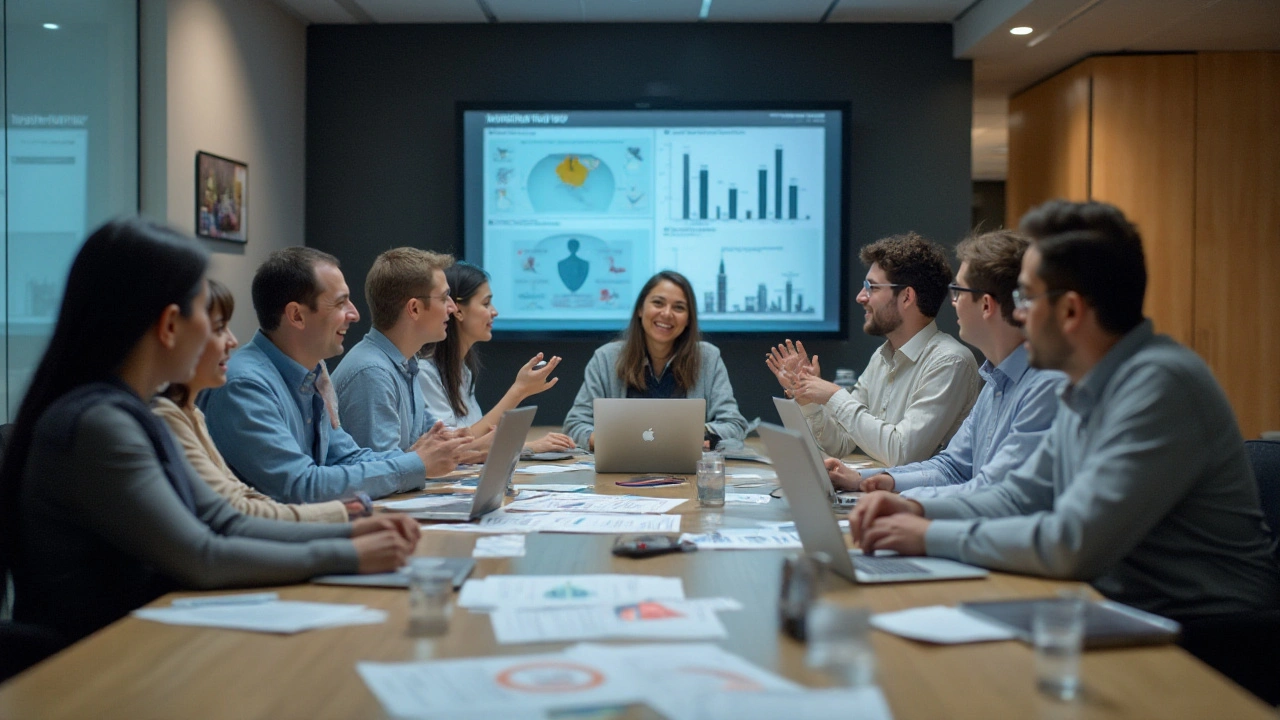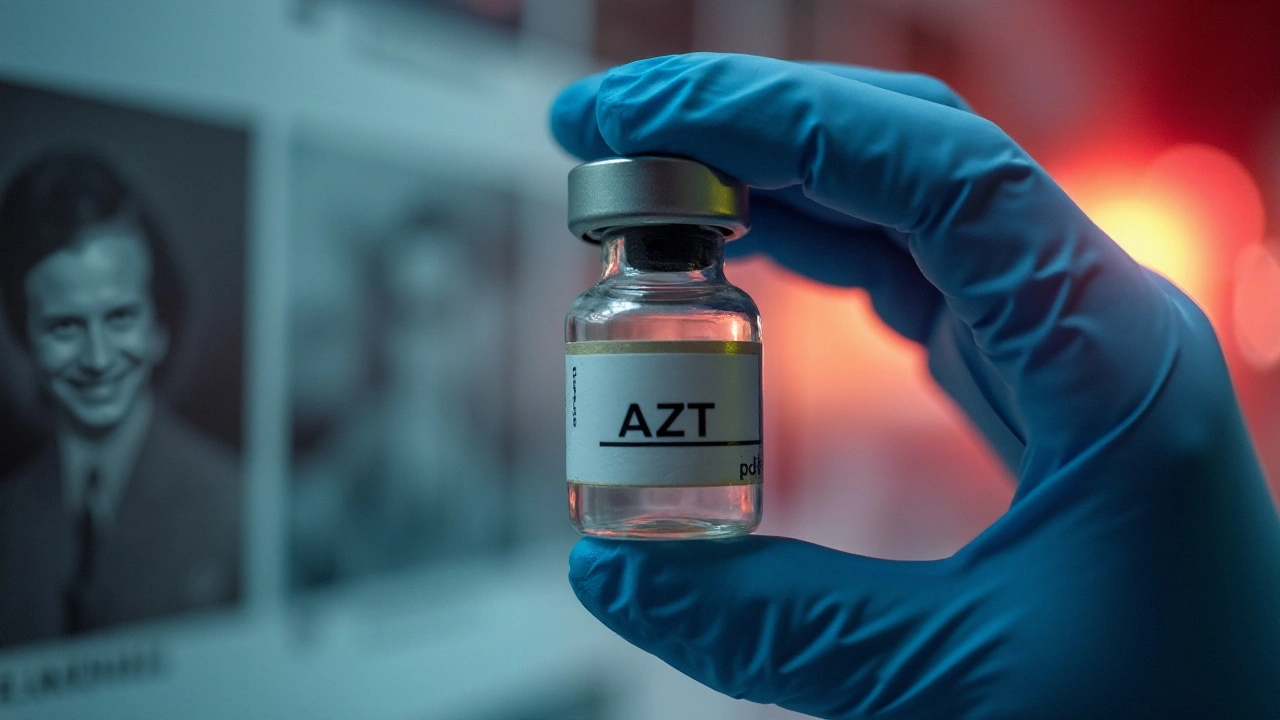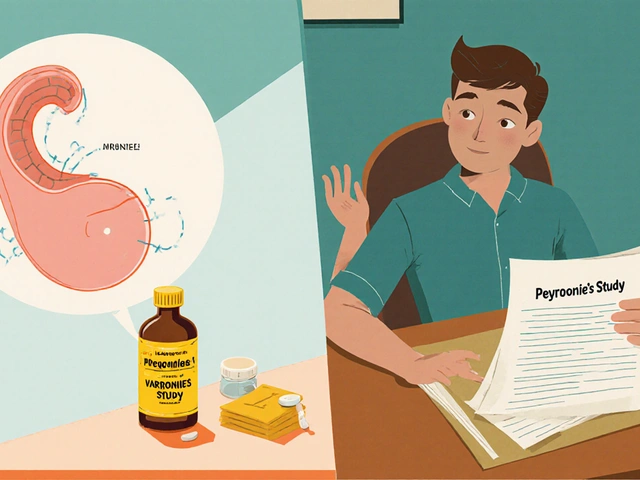HIV and AIDS have been at the forefront of medical challenges for decades. One of the pivotal moments in the battle against this virus was the introduction of Zidovudine, more commonly known as AZT. This drug was the first of its kind approved for HIV treatment, offering hope at a time when the epidemic was especially devastating.
The journey towards finding a definitive cure for HIV is filled with both significant advancements and ongoing struggles. Scientists around the world are constantly unveiling new research, testing groundbreaking therapies, and pushing the boundaries of medical science in their quest to cure HIV once and for all.
- History of Zidovudine
- How Zidovudine Works
- Challenges in HIV Treatment
- Current Research and Developments
- Innovative Therapies on the Horizon
- Future Possibilities for an HIV Cure
History of Zidovudine
The story of Zidovudine, often referred to by its initials AZT, began long before it became known as a front-line treatment for HIV/AIDS. Originally synthesized in 1964 by Jerome Horwitz, it was intended as a cancer treatment. However, it lingered in obscurity for two decades because it did not show any efficacy in its initial purpose. It was not until the 1980s, amid the emerging AIDS crisis, that AZT found its true calling.
In 1984, researchers at Burroughs Wellcome, now part of GlaxoSmithKline, discovered that AZT was effective against the HIV retrovirus in vitro. This ushered in a rapid, and rigorous, development and testing phase. By 1987, AZT received fast-track approval from the U.S. Food and Drug Administration (FDA), making it the first drug approved for the treatment of AIDS. This was a groundbreaking achievement, as the medical community at the time was grappling with an escalating number of HIV cases with no effective treatments in sight.
The approval of AZT was a moment of hope and promise. It represented the first flicker of light in what had been a very dark tunnel. The New York Times heralded it as a major breakthrough. However, it is essential to note that AZT was not without criticism. Patients taking high doses experienced severe side effects including anemia and liver toxicity. This led to a significant amount of debate within the scientific community over the optimal dosing strategy and long-term safety of AZT.
Despite these challenges, AZT marked a turning point in HIV treatment. It paved the way for the development of other antiretroviral drugs. Over the years, treatment regimens have evolved, and combination therapies that include AZT or its derivatives have become the standard approach. The introduction of AZT also spurred further research and significant investments in HIV/AIDS science, leading to the robust treatment options available today.
AZT's legacy is multifaceted. It was the first drug to demonstrate that antiviral treatments could manage HIV, transforming what was once considered a death sentence into a manageable chronic condition. “It was the drug that turned the tide,” said Dr. Anthony Fauci, former director of the National Institute of Allergy and Infectious Diseases.
“Without AZT, we might not have gotten the level of investment and scientific interest needed to tackle HIV with the intensity we did.”
How Zidovudine Works
Zidovudine, or AZT, is a pioneer medication in the fight against HIV/AIDS. It was the first drug approved to treat HIV infection and it works by inhibiting the replication of the virus inside the human body. The secret lies in its ability to block a vital enzyme known as reverse transcriptase. This enzyme is crucial for HIV because it converts the virus's RNA into DNA, allowing it to integrate into the host's cells and reproduce.
When Zidovudine enters the bloodstream, it gets converted into an active form called Zidovudine triphosphate. This active form competes with natural building blocks of DNA and incorporates itself into the growing DNA chain. However, unlike the natural building blocks, Zidovudine triphosphate terminates the DNA chain prematurely, thereby halting the virus's ability to replicate itself.
Dr. Robert Gallo, a prominent researcher in the field, once said,
Zidovudine marked a turning point in HIV treatment, providing a lifeline where there was none before.It's important to note, though, that while AZT was groundbreaking, it wasn't a cure. The virus could develop resistance over time, rendering the drug less effective. This led to the development of combination therapies, where AZT is used alongside other antiretroviral drugs to enhance its effectiveness and reduce resistance.
Side Effects and Management
Like many potent medications, Zidovudine comes with its share of side effects. Common issues include nausea, headaches, and anemia. More serious side effects can involve damage to the muscles and liver. These effects resulted in a cautious approach to its usage and necessitated regular monitoring of patients in early treatment protocols.
Doctors often recommend regular blood tests to monitor the levels of the drug and its effects on the body. This careful management helps in maximizing the benefits of Zidovudine while minimizing its risks. Despite its side effects, Zidovudine's role in early HIV treatment cannot be understated.
The advent of combination therapy, where Zidovudine is used with other antiretroviral drugs, has considerably improved patient outcomes. Combination therapy reduces the likelihood of drug resistance and helps in maintaining a lower viral load in patients, which is crucial for long-term health and reduced transmission rates.
Recent statistics suggest that the use of combination therapies has reduced the AIDS-related deaths significantly since the peak of the epidemic. This is a testament to how initial breakthroughs like Zidovudine have paved the way for continual improvements in HIV treatment and care.

Challenges in HIV Treatment
Despite leaps in medical science, treating HIV remains complex. One primary challenge is the virus's ability to mutate rapidly. This adaptability enables HIV to resist treatments over time, making it a moving target for medication. While drugs like Zidovudine have dramatically slowed the progress of the disease, they are not a cure, and the virus often finds ways to circumvent these medications.
Another significant issue is the burden of lifelong treatment. Individuals with HIV must adhere to daily medication regimens, which can be taxing both mentally and financially. The need for consistent adherence to treatment raises the stakes even higher; missing doses can lead to drug resistance, rendering the medication less effective or even useless.
“One of the biggest challenges in fighting HIV is ensuring that patients adhere to their medication schedules. This is crucial because the virus can rebound quickly, causing more harm and resistance,” says Dr. Anthony Fauci, a leading immunologist.Adherence becomes even more challenging in resource-limited settings where access to medication is inconsistent. In many parts of the world, particularly in low-income regions, the cost and availability of HIV drugs present significant barriers. Without proper access, the disease continues to spread unchecked, deepening the crisis.
Beyond the patient's adherence to treatment, stigma surrounding HIV/AIDS remains a daunting obstacle. Stigma leads to discrimination, which can deter people from seeking diagnosis or treatment. This not only affects the health of individuals but also hampers broader public health efforts.
Side effects from HIV medications pose another set of challenges. While drugs have become more effective over the years, they often bring along a host of side effects such as nausea, fatigue, and more severe complications like liver or kidney damage. These side effects can discourage patients from sticking to their treatment plans, worsening the cycle of non-adherence.
Healthcare systems face their own set of hurdles in combating HIV. The need for regular blood tests to monitor drug effectiveness and virus levels strains healthcare resources. In many regions, the infrastructure to support ongoing, intensive monitoring of patients simply doesn’t exist. This gap disproportionately affects marginalized communities, leading to disparities in treatment outcomes.
Another layer of complexity is the co-infection with other diseases like tuberculosis and hepatitis. These co-infections can complicate the treatment and management of HIV, requiring more comprehensive and costly healthcare interventions. Balancing the treatment for multiple conditions adds another layer of stress for both patients and healthcare providers.
Emerging drug resistance is increasingly becoming a global issue. As HIV continues to adapt and change, scientists are in a race against time to develop new drugs to keep pace with the virus. This continual need for innovation adds to the overall cost and complexity of treating HIV comprehensively.
Finally, funding and political will are critical in the fight against HIV. Sustainable funding is required not just for medication, but also for research, education, and prevention programs. Political climates and policy decisions can have substantial impacts on the allocation of resources, influencing how effectively HIV can be combated on a global scale.
Current Research and Developments
Recent years have witnessed some groundbreaking HIV treatment advancements. Researchers are exploring several promising avenues to combat the virus more effectively. One significant area of focus is gene editing, spearheaded by the technology known as CRISPR-Cas9. This method allows scientists to cut out specific parts of the HIV genome, potentially halting the virus's ability to replicate. Such interventions could revolutionize our approach to dealing with HIV infections in the future.
Another exciting development is the advent of long-acting antiretroviral therapies. Offering patients more convenience and reducing the need for daily medication, these medications can be administered monthly or even quarterly. Recent clinical trials have shown promising results, with some drugs significantly reducing the viral load. This innovation is particularly crucial for improving the quality of life and adherence to treatment regimes for many people living with HIV.
In the realm of vaccines, scientists are making headway, though it remains a challenging area. The mosaic vaccine is one of the hopeful candidates. It uses pieces from different HIV strains to provoke a broader immune response, potentially offering protection against multiple varieties of the virus. Although creating an effective HIV vaccine is complex due to the virus's high mutation rate, each step forward brings us closer to a viable solution.
Stem cell research is another fascinating field that offers hope. Some studies have shown that patients who underwent stem cell transplants for other conditions also experienced a functional cure for HIV. This phenomenon, known as the

Innovative Therapies on the Horizon
For the past few years, the medical community has been buzzing with excitement about several innovative therapies aimed at curing HIV. These new approaches go beyond the traditional anti-retroviral treatments, probing deeper into the virus's hiding spots and promising new hope for millions worldwide. One of the most promising areas of research is the use of gene editing tools, particularly CRISPR-Cas9. This technique allows scientists to 'cut out' the HIV DNA from the infected cells, which could potentially eliminate the virus altogether. Although still in the experimental stages, early results have been promising, indicating that this could one day be a game-changer.
Another fascinating development is the use of broadly neutralizing antibodies (bNAbs). These antibodies can recognize and attack a wide range of HIV strains, something traditional treatments struggle to do. Recent trials have shown that bNAbs can significantly reduce viral loads in people living with HIV. Researchers hope that combining these antibodies with other treatments could lead to longer-lasting viral suppression and, ultimately, a cure. There's an ongoing study at the National Institutes of Health examining the effects of bNAbs in individuals who have stopped taking conventional anti-retroviral drugs.
The results so far have been promising, with many participants maintaining undetectable viral loads for months. ‘This is encouraging news, but we still have a long way to go,’ said Dr. Anthony Fauci, a prominent figure in HIV research.
Stem cell transplants have also emerged as a beacon of hope. Tim Brown, also known as the 'Berlin Patient,' and Adam Castillejo, the 'London Patient,' are the first two individuals considered cured of HIV following stem cell transplants for cancer treatment. These cases have inspired a slew of research projects investigating the potential of stem cell therapies to provide a cure for HIV. Although the procedure is risky and not feasible on a large scale, it has proven that HIV can indeed be eradicated from the body.
In addition to these high-tech solutions, researchers are also exploring therapeutic vaccines designed to boost the immune system's ability to fight HIV. Unlike preventive vaccines, which aim to stop infection, therapeutic vaccines are intended for those already living with the virus. A compelling study published recently highlighted the potential of an experimental vaccine called AGS-004. Participants who received the vaccine showed not only a strengthened immune response but also a reduction in viral loads.
Each of these innovative strategies represents a step closer to an HIV cure. While challenges remain, the progress made in recent years gives hope that an end to this long-standing epidemic might be within reach. Researchers are optimistic that a combination of these therapies, tailored to individual patients, could one day lead to a functional cure for HIV.
Future Possibilities for an HIV Cure
When it comes to envisioning a future free of HIV, hope is propelled by numerous ongoing studies and breakthroughs. Researchers around the globe are committed to not just treating but eradicating this virus. Among the most exciting prospects are gene therapy, stem cell transplants, and latency-reversing agents. These methods hold the potential to eliminate HIV from the body completely.
Zidovudine laid the foundation for antiretroviral therapy, but the ultimate goal remains a cure. One approach that has gained traction is gene editing. CRISPR-Cas9 technology, in particular, offers a unique way to target and remove HIV DNA from infected cells. This could mean a permanent end to the virus within the host. Imagine a future where a one-time treatment could eradicate HIV without the need for lifelong medication.
"We are in an era where the science of HIV therapy is advancing at an unprecedented pace," says Dr. Anthony Fauci of NIAID. "The potential for gene editing to offer sustained, if not lifelong, remission is incredibly promising."
Stem cell transplants have also shown promise, particularly in the case of the so-called "Berlin Patient." This individual was seemingly cured of HIV after receiving a bone marrow transplant from a donor with a rare genetic mutation that provides resistance to the virus. While this procedure is complex and risky, it has opened up new avenues for research.
Another exciting area of study involves latency-reversing agents. These are drugs designed to "wake up" dormant HIV cells so that they can be targeted and destroyed by the immune system or antiretroviral therapy. By addressing the virus reservoirs, these agents could pave the way to clearing HIV from the body entirely. This approach is often referred to as the "shock and kill" strategy.
Innovative therapies are not without their challenges. For one, the virus' ability to mutate quickly means that any cure would need to address multiple strains. Additionally, the accessibility and cost of new treatments are significant hurdles that researchers must consider. Ensuring that any potential cure is both effective and accessible to people worldwide is crucial.
Currently, a combination of preventive measures, such as pre-exposure prophylaxis (PrEP) and education, continues to play a vital role in reducing new HIV infections. But the dream of a world where HIV is no longer a threat drives researchers to push the boundaries of science. With each passing year, the strides made in the quest for an HIV cure bring us closer to turning that dream into reality.







katerine rose
11 September 2024 - 03:58 AM
AZT was a miracle drug back then but now it's like using a flip phone in 2024 lmao
Iris Schaper
11 September 2024 - 16:08 PM
It's wild to think that something once seen as a death sentence is now manageable with a daily pill. AZT wasn't perfect but it cracked open the door. Sometimes progress isn't about perfection-it's about showing up when no one else will.
That said, we still treat HIV like a moral failure instead of a medical condition. The real cure isn't in the lab-it's in how we stop stigmatizing people who live with it.
Selma Cey
11 September 2024 - 22:55 PM
So AZT was the first drug... and now we have drugs that don't turn your blood into sludge? Interesting. But let's be real-this whole 'cure' narrative feels like corporate hype. They don't want a cure. They want lifelong customers.
Think about it. If HIV disappeared, how many billions in annual revenue would vanish? Pharma doesn't cure diseases. They monetize management.
Francis Pascoe
13 September 2024 - 00:52 AM
They let a 1960s cancer drug become the frontline treatment for AIDS and called it a breakthrough? That’s not science-that’s desperation wrapped in a lab coat. And now we’re talking about CRISPR like it’s magic? Wake up. We’re still playing whack-a-mole with a virus that evolved before we could spell 'retrovirus'.
They’re not curing HIV. They’re just making sure you pay for it forever.
Richa Shukla
13 September 2024 - 10:08 AM
AZT was a government experiment to kill gay people lmao. They knew it was toxic but pushed it anyway because they didn't care about us. Now they're selling 'cures' like it's a miracle? Nah. It's all a scam. The real cure is in the moon. They just don't want you to know.
Check the chemtrails. They're syncing with the HIV trials. I've seen the documents. 😈
Chris Rowe
15 September 2024 - 06:45 AM
First drug approved for AIDS? Bro, that's like saying the first wheel was a breakthrough. It was round, sure, but it still didn't work great. Now we got pills you take once a month and you're chill. But nah, let's keep pretending AZT was some genius move.
Also, who still uses 'Zidovudine'? Say AZT, jeez.
Sushmita S
16 September 2024 - 19:39 PM
So AZT was the first... and now we got bNAbs and CRISPR? 😍
Still, why do I feel like the real cure is just better access to meds? Not tech. Not hype. Just pills for everyone. 🙏
AnneMarie Carroll
17 September 2024 - 08:58 AM
You people are so naive. AZT was a Band-Aid on a severed artery. The fact that we're still talking about 'cures' instead of systemic healthcare reform proves how broken this system is.
People in Nigeria and India still die because they can't afford the *new* drugs. You think CRISPR will be free? Please. The cure will be a luxury subscription. And you'll be the one paying for it.
Stop romanticizing science. It's capitalism with a white coat.
John K
18 September 2024 - 00:24 AM
USA invented AZT. USA leads the cure. Other countries? They just copy. Why? Because we built the labs, funded the research, and didn't let politics stop progress. If you're not grateful, move to a country that doesn't care. 🇺🇸💪
Also, CRISPR? That's American tech. No one else could've done it. Period.
Laura Anderson
18 September 2024 - 08:46 AM
The historical irony of AZT lies not in its pharmacological mechanism but in its sociopolitical instantiation as a symbol of late-capitalist medical triage: a molecule born of failed oncology repurposed as a palliative for a pandemic disproportionately affecting marginalized populations.
Its legacy is not therapeutic efficacy per se, but the institutionalization of pharmaceutical intervention as the sole vector of moral redemption in public health discourse. We elevated a toxic compound to savior status not because it worked-but because we needed a narrative.
Today’s gene-editing hype merely reenacts this mythmaking. The cure is not in the genome. It is in the redistribution of care.
Avis Gilmer-McAlexander
20 September 2024 - 00:29 AM
I love how we went from 'AZT might kill you faster than the virus' to 'we might erase HIV from your DNA with a single treatment'.
It’s like watching someone build a raft after a flood, then decades later invent a submarine. The journey’s messy, full of wrong turns, but we kept going. Not because it was easy-but because people refused to let others die quietly.
That’s the real breakthrough. Not the science. The stubborn, messy, human refusal to give up.
Jerry Erot
21 September 2024 - 00:51 AM
Interesting that you mention AZT’s side effects but ignore that the mortality rate dropped by 70% in the first year of use. The science isn’t perfect, but the data speaks. You can’t dismiss progress because it’s imperfect.
Also, CRISPR isn’t a magic bullet, but it’s the most promising tool we’ve had since antiretrovirals. The fact that you’re skeptical doesn’t make it wrong.
Fay naf
21 September 2024 - 12:09 PM
Let’s be clear: AZT was a pharmacological farce masquerading as salvation. The FDA approval was a PR stunt to quell public panic, not a triumph of science.
Today’s 'innovative therapies' are just rebranded profit engines-bNAbs? Patentable. CRISPR? Patentable. Stem cells? Patentable. The cure isn’t the goal. The monopoly is.
And don’t get me started on Fauci. He’s the poster child for institutional capture. His 'hope' is just a marketing slogan for Big Pharma’s next quarterly report.
ANTHONY SANCHEZ RAMOS
23 September 2024 - 09:23 AM
Man, I didn’t know AZT was from the 60s 😳
But now we got stuff that works for MONTHS not days? That’s wild. I got a cousin on PrEP and he says it’s like taking a vitamin. No more panic. Just life.
CRISPR sounds like sci-fi but I’m all for it. Let’s get this cure already. 💪🧬❤️
Matt Czyzewski
24 September 2024 - 05:16 AM
One cannot discuss the therapeutic trajectory of HIV without acknowledging the epistemological rupture that AZT precipitated. Prior to its introduction, virology was a field of speculative observation; afterward, it became a domain of pharmacological intervention.
The transition from fatalism to management was not merely clinical-it was ontological. We began to conceive of the virus not as an inevitability, but as a controllable variable.
Today’s gene-editing efforts are not an evolution of AZT-they are its transcendence. Yet, we must not forget: the first step is always the most terrifying.
John Schmidt
25 September 2024 - 06:41 AM
Oh wow, AZT was the first? Cute. Let me guess-also the most toxic? Of course it was. They gave people poison because they had no other options and called it progress.
And now we’re all excited about CRISPR like it’s a gift from the gods? Newsflash: it’s still in mice. Meanwhile, people in the Global South are still dying because they can’t get the *old* drugs.
Y’all act like science is a fairy tale. It’s not. It’s politics with a pipette.
Lucinda Harrowell
25 September 2024 - 13:27 PM
It’s strange how we celebrate the first drug that barely worked, but rarely talk about the thousands of people who fought for it-patients, activists, nurses who held hands as people died.
AZT wasn’t the hero. The people who demanded it were.
Now we have better tools. Let’s make sure they reach everyone. Not just the lucky ones.